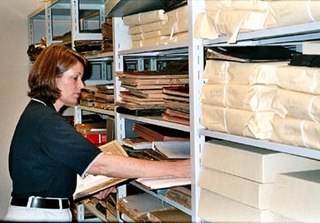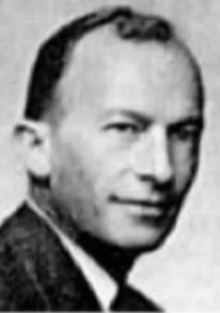Related Research Articles

An archivist is an information professional who assesses, collects, organizes, preserves, maintains control over, and provides access to records and archives determined to have long-term value. The records maintained by an archivist can consist of a variety of forms, including letters, diaries, logs, other personal documents, government documents, sound and/or picture recordings, digital files, or other physical objects.
In archival science, a fonds is a group of documents that share the same origin and that have occurred naturally as an outgrowth of the daily workings of an agency, individual, or organization. An example of a fonds could be the writings of a poet that were never published or the records of an institution during a specific period.
Encoded Archival Description (EAD) is a standard for encoding descriptive information regarding archival records.

Archival science, or archival studies, is the study and theory of building and curating archives, which are collections of documents, recordings, photographs and various other materials in physical or digital formats.
Archival processing is the act of surveying, arranging, describing, and performing basic preservation activities on the recorded material of an individual, family, or organization after they are permanently transferred to an archive. A person engaging in this activity is known as an archival processor, archival technician, or archivist.
In archival science and archive administration, appraisal is a process usually conducted by members of the record-holding institution in which a body of records is examined to determine its value for that institution. It also involves determining how long this value will last. The activity is one of the central tasks of an archivist, to determine the archival value of specific records. When it occurs prior to acquisition, the appraisal process involves assessing records for inclusion in the archives. In connection with an institution's collecting policy, appraisal "represents a doorway into the archives through which all records must pass". Some considerations when conducting appraisal include how to meet the record-granting body's organizational needs, how to uphold requirements of organizational accountability, and how to meet the expectations of the record-using community.
The Australian Series System is an archival control or metadata system, used primarily to describe records in the custody of archival institutions. It was developed at the Australian Archives and forms the basis for the Australian Society of Archivists' committee on descriptive standards guide ″Describing archives in context″.
Terence M. Eastwood is best known for his pioneering roles in archival education internationally and the creation of archival descriptive standards in Canada. He has published widely on a number of topics of importance to the development of archival theory and has lectured and presented throughout the world. His work supervising archival studies students helped craft a whole new generation of archivists who themselves have gone on to make important contributions to the field.

Archival research is a type of research which involves seeking out and extracting evidence from archival records. These records may be held either in collecting institutions, such as libraries and museums, or in the custody of the organization that originally generated or accumulated them, or in that of a successor body. Archival research can be contrasted with (1) secondary research, which involves identifying and consulting secondary sources relating to the topic of enquiry; and (2) with other types of primary research and empirical investigation such as fieldwork and experiment.

Sir Charles Hilary Jenkinson was a British archivist and archival theorist, regarded as the figure most responsible for bringing continental European concepts of archival theory to the English-speaking world.
The archival bond is a concept in archival theory referring to the relationship that each archival record has with the other records produced as part of the same transaction or activity and located within the same grouping. These bonds are a core component of each individual record and are necessary for transforming a document into a record, as a document will only acquire meaning through its interrelationships with other records.
Original order is a concept in archival theory that a group of records should be maintained in the same order as they were placed by the record's creator. Along with provenance, original order is a core tenet of the archival concept of respect des fonds. A primary goal of keeping records in their original order is to preserve additional contextual information about the records' creator and the environment of their creation. Original order also encourages the archivist to remain neutral as opposed to applying any interpretation to the records.

Theodore Roosevelt Schellenberg was an American archivist and archival theorist. Schellenberg's publications and ideas are part of the foundation for archival theory and practice in the United States. In particular, Schellenberg is known for pioneering American archival ideas about appraisal.
"More Product, Less Process: Revamping Traditional Archival Processing" is a 2005 archival science article written by Mark A. Greene and Dennis Meissner that first appeared in the Fall/Winter 2005 issue of The American Archivist. The paper argues that traditional archival processing is too slow, and advocates for the use of minimal processing in order to reduce backlogs and provide access to archival collections as quickly as possible. The ideology presented in the article, abbreviated as MPLP, has since been widely adopted in modern archival theory with subsequent praise directed primarily towards the ability to increase user accessibility without prohibiting the option for future processing.
National archives are the archives of a country. The concept evolved in various nations at the dawn of modernity based on the impact of nationalism upon bureaucratic processes of paperwork retention.

The records continuum model (RCM) is an abstract conceptual model that helps to understand and explore recordkeeping activities. It was created in the 1990s by Monash University academic Frank Upward with input from colleagues Sue McKemmish and Livia Iacovino as a response to evolving discussions about the challenges of managing digital records and archives in the discipline of archival science.
Hugh Alexander Taylor was an English-born Canadian archivist, archival theorist and educator.
Heather MacNeil is a professor at the Faculty of Information of the University of Toronto, Canada. She teaches archives and record keeping related topics. She is a former General Editor of Archivaria (2014-2015) and helped develop the concept of the Archival bond.

Emmett Joseph Leahy was an American archivist and entrepreneur. He was a pioneer in the discipline of records management. After working in the National Archives and then during World War II in the United States Navy, he entered private business as a consultant in records management and as a records storage provider. He also participated in the two Hoover Commissions in improving the efficiency and effectiveness of government.
Jennifer Douglas is a Canadian archivist and academic who researches the creation of personal archives and their place within with traditional archival practice.
References
- 1 2 "provenance". Dictionary of Archives Terminology. Society of American Archivists. Retrieved 22 May 2020.
- ↑ "archival integrity". Dictionary of Archives Terminology. Society of American Archivists. Retrieved 22 May 2020.
- 1 2 3 Duchein, Michel (Summer 1983). "Theoretical Principles and Practical Problems of Respect des Fonds in Archival Science". Archivaria. 16: 64–82.
- ↑ Bartlett, Nancy (1992). "Respect des Fonds" in Bibliographical foundations of French historical studies. McCrank, Lawrence J., Association for the Bibliography of History (U.S.). New York: Haworth Press. ISBN 1560241500. OCLC 24068905.
- ↑ Duranti, Luciana (Spring 1993). "Origin and Development of the Concept of Archival Description". Archivaria. 35: 50.
- ↑ Gilliland, Anne J. (2000). Enduring paradigm, new opportunities : the value of the archival perspective in the digital environment. Council on Library and Information Resources. ISBN 1887334742. OCLC 43564387.
- ↑ "Record Group Concept". National Archives. 15 August 2016. Retrieved 11 April 2019.
- ↑ Internet Archive. "International Congress of Archivists and Librarians: Brussels, 1910" . Retrieved 1 January 2016.
- ↑ Jenkinson, Hilary (1937). A Manual of Archive Administration (2nd ed.). London: P. Lund, Humphries & Co. p. 101.
- ↑ Eastwood, Terence M. (1992). The Archival fonds: from theory to practice. [Ottawa]: Bureau of Canadian Archivists, Planning Committee on Descriptive Standards = Bureau Canadien des archivistes, Comité de planification sur les normes de description. ISBN 0969079761. OCLC 26858673.
- ↑ Weimer, Larry (2007). "Pathways to Provenance: DACS and Creator Descriptions". Journal of Archival Organization. 5 (1–2): 33–48. doi:10.1300/J201v05n01_03.
- ↑ Barrett, Creighton (Fall 2013). "Respect Which Fonds? Personal Archives and Family Businesses in Nova Scotia". Archivaria. 78: 75–92.
- ↑ Fenyo, Mario (April 1966). "The Records Group Concept: A Critique". The American Archivist. 29 (2): 229–239. doi: 10.17723/aarc.29.2.n42715175094503m .
- ↑ Boles, Frank (1982). "Disrespecting Original Order". The American Archivist. 45 (1): 26–32. doi: 10.17723/aarc.45.1.94g0502t2g81053g .
- ↑ Eastwood, Terry (2000). "Putting the Parts of the Whole Together: Systematic Arrangement of Archives". Archivaria. 50: 93–116.
- ↑ Moore, Lara (2008). Restoring Order: The Ecole Des Chartes and the Organization of Archives and Libraries in France, 1820–1870. Duluth, Minnesota: Litwin Books. ISBN 978-0977861798.
- ↑ Greene, Mark; Meissner, Dennis (2005). "More Product, Less Process: Revamping Traditional Archival Processing". The American Archivist. 68 (2): 208–263. doi:10.17723/aarc.68.2.c741823776k65863. ISSN 0360-9081.
- ↑ Bunn, Jenny (2014). "Questioning Autonomy: An Alternative Perspective on the Principles which Govern Archival Description". Archival Science. 14: 3–15. doi:10.1007/s10502-013-9200-2.
- ↑ Baker, Penelope (2018). "Back-bone or burden?: the role of the RPS in the BRA". Archives. 53 (136): 27–44 (32–33).